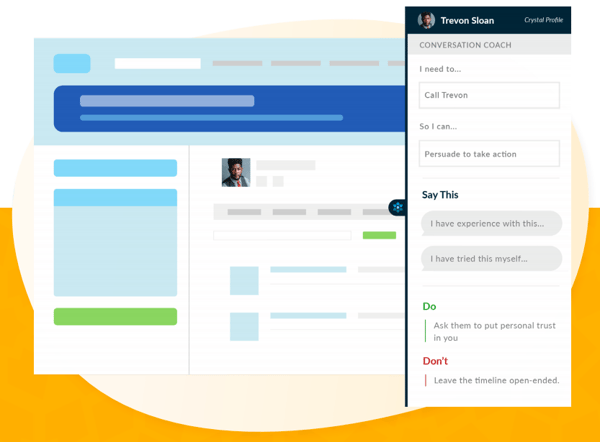
Within the first 30 seconds of the call, my confidence deflated.
Striking out
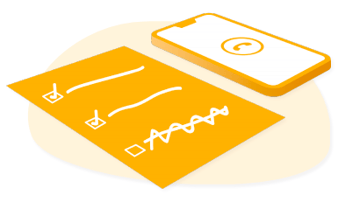 It was my third demo of the day and I was feeling energized. I stacked my schedule with calls to discuss our event management software with a long list of promising leads, mostly university event managers. The first two calls were encouraging and energizing: both prospects seemed to like our product and asked me to send back pricing. Now that I was warmed up, it was time for my biggest fish of the day, a call with a Director of Events at a large midwestern university, who we’ll call Mike.
It was my third demo of the day and I was feeling energized. I stacked my schedule with calls to discuss our event management software with a long list of promising leads, mostly university event managers. The first two calls were encouraging and energizing: both prospects seemed to like our product and asked me to send back pricing. Now that I was warmed up, it was time for my biggest fish of the day, a call with a Director of Events at a large midwestern university, who we’ll call Mike.
Within the first 30 seconds of the call, my confidence deflated.
Eager to get started, I dove right into my pitch. I wanted to make the best use of our time, of course, but he responded coldly, and even seemed a bit agitated. As I continued, he cut me off and asked how long I had been working in sales. I glanced at the clock and, realizing we only had 22 minutes left, quickly responded, “about a year.” I tried to get back on track, but again and again he would stop me to ask questions that had nothing to do with the product. It was frustrating for me; I felt rushed and under pressure to cover every detail in my limited time slot. When I mentioned pricing, he seemed taken aback, as if I had mentioned it too early. I asked him what he thought about our services and he hesitated in answering.
I then asked him what he thought best next steps were and while not directly answering the question, he went into a long description of the university’s committee purchasing process, approvals and the other colleagues that would need to see a demo. That sent me a signal (so I thought): they were not very interested and were unlikely to move forward. It was clear that this call did not go well.
Why is each phone call and meeting so unique?
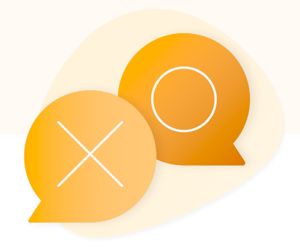
Though you may have pitched the same idea or presented a product hundreds of times, every audience may perceive your presentation differently. Without making an effort to adjust, it’s easy to pitch our idea or present a product in a way that feels familiar and appealing to us. The core problem is that we, by default, neglect to consider how others with different personality traits, communication preferences, and values might interpret our communication style.
How do we break through the noise and be relevant?
We all have the tendency to assume that everyone else wants to communicate in the same way we do. Psychology, neuroscience, and real-world experiences teaches us that this couldn’t be further from the truth. People have very different backgrounds, feelings, thoughts, behaviors, and communication preferences, making it nearly impossible to communicate effectively with someone without taking into account their preferred communication style. Rather than ignorantly addressing someone in the way we want, we need to learn to communicate the way they want. In summary, we need to communicate with empathy.
And in order to communicate with empathy, we need to understand the other person’s personality and communication style.
Understanding personality
Historically, the only way you would be able to fully understand someone’s personality is by either getting to know them really well, which takes lots of time and emotional intelligence, or having them take a personality test. Both of these approaches require that you have an established relationship with the person, which doesn’t tend to work in the world of outreach communication, since we are often trying to connect with new people who we have never spoken with before.
Thankfully, there is a new technology that unlocks another way to learn about someone’s personality without an assessment - Personality AI. We wrote about this in detail in another ebook titled, Personality AI (which you can download for free). This new technology analyzes publicly available information on websites like LinkedIn to predict someone’s personality, using artificial intelligence and machine learning. We built our product, Crystal, to harness Personality AI and enable anyone to identify personalities online to improve their communication and build stronger relationships, all based on the core principle of empathy.
Without getting too technical, when Crystal’s AI predicts personality, it uses a framework called DISC to classify personalities into a few categories that we refer to as D (dominance), I (influence), S (steadiness), and C (conscientiousness). Each of us has a primary DISC type in one of these categories and sometimes a secondary DISC type in another. To keep things simple, we separate these into easy-to-remember labels called Archetypes.
You can see them all on this graphic called the Personality Map:
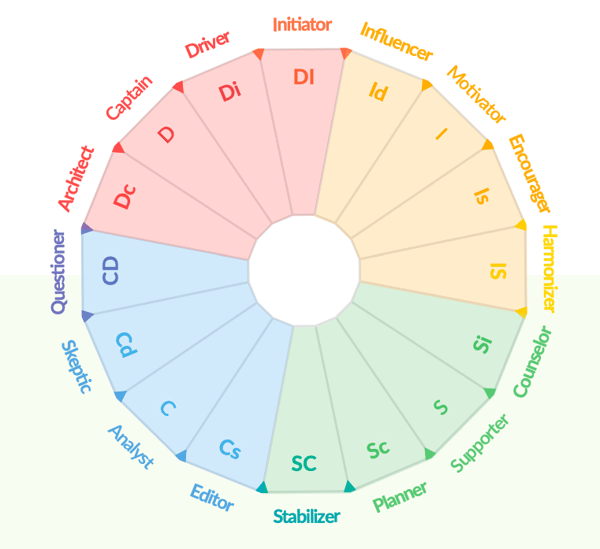
Below is a breakdown of common personality traits within each of the categories in DISC.
D Personality Types: Captains, Drivers, Initiators, Architects
- Motivated by control over the future and personal authority
- Tend to prefer instant, concrete results and having an advantage over competition
- Communicate clearly and succinctly
I Personality Types: Influencer, Motivator, Encourager, Harmonizer
- Motivated by innovative, unique, creative ideas and excited by the future
- Tend to prefer building new relationships and experiences
- Communicate in a casual, expressive way
S Personality Types: Counselor, Supporter, Planner, Stabilizer
- Motivated by peace, safety, and others’ wellbeing
- Tend to prefer security, reliability, and trust
- Communicate in a friendly and genuine way
C Personality Types: Editor, Analyst, Skeptic, Questioner
- Motivated by logic, information, and problem solving
- Tend to prefer accurate information and quality solutions (quality over quantity)
- Communicate in a business-like, fact-based way
These differences are extremely important to understand when approaching a conversation with anyone. For example, someone who is a warm, people-oriented Supporter (S) is less likely to engage in a discussion about facts and data. They’d usually prefer to engage in a more personal, get-to-know-you conversation. An Analyst (C), on the other hand, tends to enjoy learning more about specific, concrete information. By identifying someone’s personality type, we can learn how to best communicate with them.
How to have an effective call or meeting
When planning a call or meeting, it’s important to consider the following three questions:
What do they want?
Why do they want it?
How do they want to interact?
By thinking in this way, you’re setting yourself up for effective, empathetic communication.
|
DISC TYPE |
DO |
DON’T |
|
D Personality Types Types: Captain, Driver, Initiator, Architect |
- Get to the point of the conversation - Ask direct questions - Ask them to choose the time and/or place |
- Engage in small-talk - Be passive or reserved - Let the call or meeting run past its scheduled time |
|
I Personality Types Types: Influencer, Motivator, Encourager, Harmonizer |
- Ask for a more immediate meeting or call time - Engage in small-talk and build rapport - Remain enthusiastic and empathetic |
- Speak in a serious tone - Involve too many details - Schedule far in advance |
|
S Personality Types Types: Counselor, Supporter, Planner, Stabilizer |
- Ask questions about how they’re feeling - Thank them for their time - Maintain a warm tone |
- Be blunt or forceful - Require an immediate decision - Forget to engage in friendly, casual conversation first |
|
C Personality Types Types: Editor, Analyst, Skeptic, Questioner |
- Provide evidence and data to support claims - Use business-like language and tone - Communicate the most important details beforehand in writing |
- Interrupt or change the subject - Make claims that you can’t support - Involve unnecessary small-talk |
Setting
 Anyone who feels like they’ve been in the wrong place at the wrong time can tell you just how much setting matters. The environment surrounding the discussion is important; you wouldn’t likely propose to someone in the gas station for the same reason you probably wouldn’t wear flip flops to a wedding - it’s not the right setting. In the context of personality, it’s important to recognize where different people like to conduct meetings.
Anyone who feels like they’ve been in the wrong place at the wrong time can tell you just how much setting matters. The environment surrounding the discussion is important; you wouldn’t likely propose to someone in the gas station for the same reason you probably wouldn’t wear flip flops to a wedding - it’s not the right setting. In the context of personality, it’s important to recognize where different people like to conduct meetings.
D-types are assertive and energetic. It’s best to call or drop by to meet with D-types when necessary, rather than spending too much time trying to plan ahead.
I-types are social and creative. They don’t tend to schedule meetings in advance; instead, they tend to prefer casual, in-person meetings at a coffee shop or a cool lunch spot (though video calls will suffice, when necessary).
S-types are warm and friendly and tend to enjoy meeting in-person, following an established agenda.
C-types are usually pragmatic and reserved; they enjoy setting specific meeting times in advance and abiding by a previously-sent plan for the discussion.
Beginning the Conversation
If you’ve ever spoken in front of a group, you’ve noticed just how differently people behave. Some make pinpointed eye-contact, while others are likely to look down at their twiddling thumbs. Meetings are the same way.
It’s important to be aware of how others would like to be addressed in order to properly communicate your point.
With D-types, get right to the point and avoid lengthy pleasantries.
Sociable I-types generally enjoy brief small talk.
S-types should be asked questions about themselves.
Be formal with C-types, but careful not to make unsupported claims.
Style
As an Architect (Dc), I may get uncomfortable with excessive displays of emotion, personal questions, or general small-talk, especially when in a set call or meeting. However, a more people-oriented Influencer (I) is more likely to be interested in a conversation like this rather than a blunt, factual discussion.
Those near the top of the Personality Map prefer fast-moving, brief discussions, while those on the bottom usually want to build trust through longer discussion.
Similarly, direct personalities on the left side of the Personality Map usually prefer to skip small-talk and get right to the point of the conversation, while those on the right side tend to enjoy engaging in casual conversation.
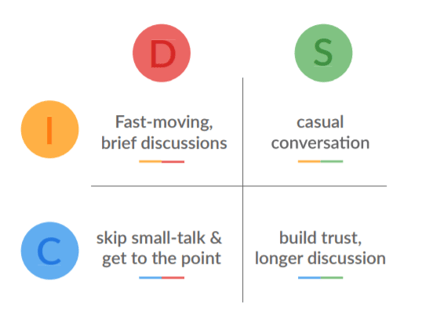
For conversations that involve needing to convince or persuade someone else, like making a sales pitch or asking for a raise, it’s important to consider the mindset of your audience.
|
DISC TYPE |
COMMUNICATION |
|
D Personality Types Types: Captains, Drivers, Initiators, Architects |
- Address certain competitive advantages - Maintain a lively, direct tone - Comment on value |
|
I Personality Types Types: Influencer, Motivator, Encourager, Harmonizer |
- Be expressive and engaging - Utilize visual aids when possible - Keep the conversation focused |
|
S Personality Types Types: Counselor, Supporter, Planner, Stabilizer |
- Ask them about personal concerns - Explain your credentials or experience - Maintain a kind, inviting tone |
|
C Personality Types Types: Editor, Analyst, Skeptic, Questioner |
- Address flaws before they do - Send important data and support for facts - Allow them to ask questions |

Call to Action
Even in verbal communication, a call to action is incredibly important. It’s your chance to make a request of the other person or take the next step in the line of action. Each personality is likely to appreciate specific types of requests:
|
DISC TYPE |
SAY THIS |
WHY? |
|
D Personality Types Types: Captains, Drivers, Initiators, Architects |
-Let’s set up a meeting. -What do you think? -Does this work for you? |
D-types value direct, concise communication. |
|
I Personality Types Types: Influencer, Motivator, Encourager, Harmonizer |
-When would be a good time for you? -How does that sound to you? -Do you want to talk through this further? |
I-types prefer more personal language and are likely to process their thoughts out loud. |
|
S Personality Types Types: Counselor, Supporter, Planner, Stabilizer |
-I’d love to hear any feedback you might have. -Would you be open to discussing this further? -Do you feel comfortable with this? |
S-types are driven by care for others. They appreciate when others show them care by asking more personal questions. |
|
C Personality Types Types: Editor, Analyst, Skeptic, Questioner |
-What other information do you need? -Do you have time for a 10-minute meeting? -Do you have any questions? |
C-types are likely to ask questions. They also like specifics, so a “10-minute meeting” is less daunting than one with no presented end time. |
Scenarios
WHAT NOT TO DO
Last year, I agreed to schedule a call with an office supplies salesperson; we’ll call her Jamie. At the time, we were growing our team and had an increased need for office supplies, which is why I was open to taking the meeting. However, once we got in the phone, it felt like we were talking different languages.
Jamie’s pitch was exceptionally enthusiastic and over-the-top. When I asked about the cost, she dodged my question and made a joke about it being worth “whatever the cost if it makes everyone’s day easier.” While Jamie meant well, she continued to pepper her pitch with jokes and personal anecdotes, meanwhile I was just thinking, “so what does it cost? What are the delivery terms?” I tried to make the call work by inquiring about package deals and challenging her bigger claims, but it felt like the details were not the focus. After what felt like 30 minutes of trying to get clear answers from Jamie, I said that we weren’t interested in purchasing at this time.
This was unfortunate, because I was actually a qualified prospect. I had the budget, authority and timeline to make a purchase. Jamie’s company may have indeed had the right products to sell me and, despite our innate differences, she was certainly capable to sell to me. This was simply a failure of communication and empathy.
What do I want?
As an Architect (Dc), I’m looking for concrete information about the products. I want to know how this will help my office be more efficient, what the specific price breakdown is, and how it will help me achieve my goals.
Why do I want it?
I typically want to reduce costs for the company, have an efficient relationship with vendors, and help make our operations run smoothly.
How do I want to interact?
When negotiating a deal like this, I tend to share my opinions openly, maintain control over information, and challenge potential solutions to find the best one.
WHAT TO DO
If Jamie wanted to reach me as a potential customer and make her call effective for an Architect (Dc), she should have:
- Skipped over the small-talk to focus on discussing the pricing and logistics
- Answered my questions directly, rather than dodging or avoiding them
- Adopted a more serious, business-like tone
- Shown how better office supplies would help me achieve my goals
- Appealed to my desire for efficiency and tangible results
If she had offered a good, clear price and a valid argument for the worth of great office supplies, I might have made a significant purchase. The lack of understanding and empathetic communication likely cost Jamie and her company an important sale.
Don’t Fly Blind
Working to communicate with others in a more personalized, intentional way can mean the difference between building an important connection (and making a sale!) and wasting your time with misunderstanding. Though personality is complex, nuanced, and compellingly difficult to comprehend, it’s important to constantly make an effort to effectively reach people in conversation.
Every call, meeting, and discussion you encounter will be different and you won’t always have much time to prepare. To help with this problem, we have developed a feature in Crystal called the Conversation Coach, which gives you scenario-specific advice for communicating with your colleagues, clients, and potential customers. Rather than flying blind, it is like having an expert sitting next to you, telling you the best way to begin the conversation, frame your message, and call others to action.
Whether you need to build personal rapport, deliver bad news, negotiate, collaborate, or close a deal, you can stop guessing about their preferred style and start communicating with confidence. Outreach professionals from the front lines all the way up to the C-suite can use these powerful new tools to be more effective everyday.
